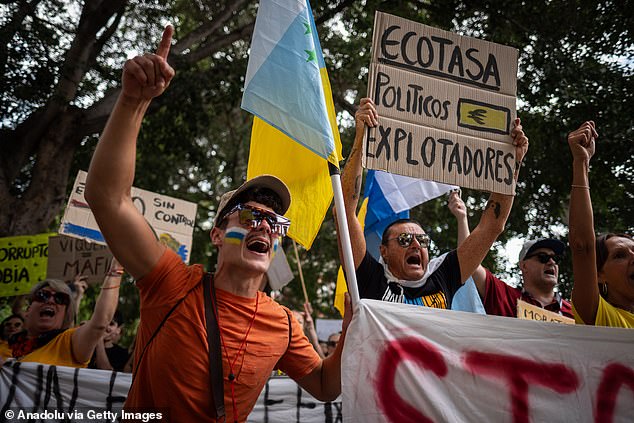Britons heading to Mallorca this bank holiday weekend face major disruption as thousands take to the streets to protest tourist overcrowding.
The popular holiday island is the latest Spanish destination to see protests, following Tenerife and the other Canary Islands last month.
The protests will take place on Saturday afternoon, starting at 7:00 p.m., and will be centered in the capital Palma.
Organizers say they are amazed by the number of groups and organizations that have pledged their support.
“At first we thought there would be about 2,000 people, but now it will be considerably more,” said a spokesman for the organizing group, Banc de Temps de Sencelles.
Thousands of people demonstrate against tourism policies on the island of Tenerife, Canary Islands, Spain, on April 20, 2024.
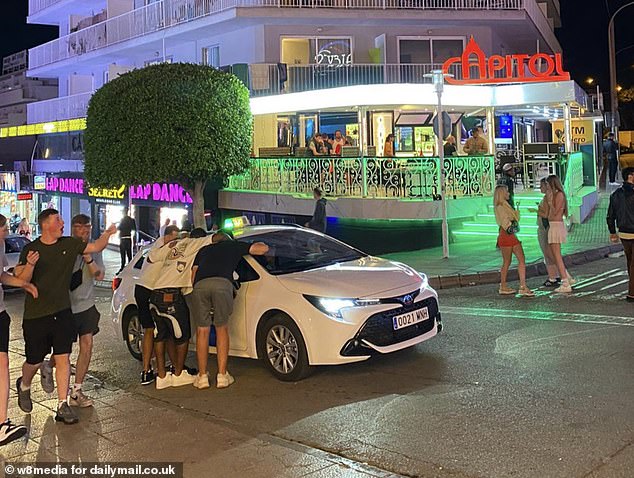
British tourists could face holiday chaos this summer as Mallorcans step up their anti-tourism campaign by threatening to blockade the island’s airport and protest outside hotels (pictured: tourists partying in Mallorca).
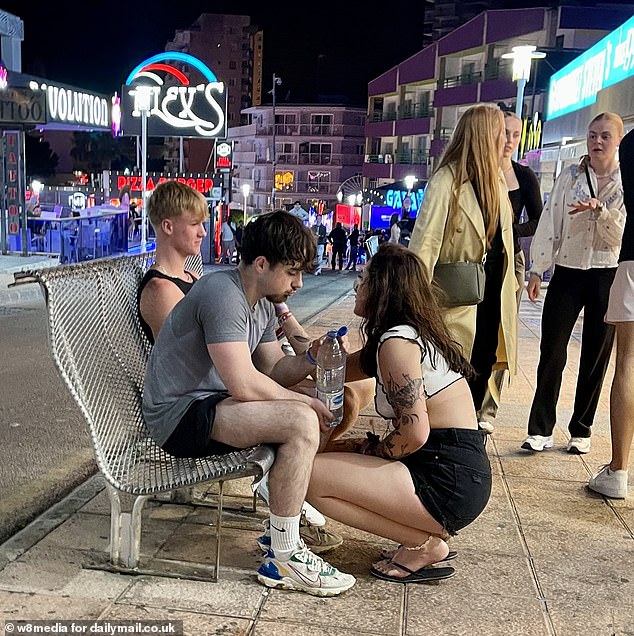
Shops in tourist hotspots such as Magaluf have been banned from selling alcohol between 9.30pm and 8am since 2020 as part of legislation the government said was the first of its kind.
The main theme of the march will be the difficulty that locals have in acquiring homes in Mallorca due to the higher prices that owners can obtain for vacation rentals.
But protesters will also highlight all the other aspects of mass tourism that they say is ruining the island.
Last week, a group under the slogan ‘Més turisme, menys vida’, which translates as ‘More tourism, less life’, said they intended to cause chaos at Palma airport over the coming weekend.
Tourist saturation has become the most important issue in Mallorca in recent months.
While residents understand that tourism is vital to local economies, patience is wearing thin.
Locals say there is traffic congestion, crowded beaches, blocked access roads, ruined beauty spots and too many tourists flocking to the island.
Mes asks for a reduction in the number of flights at Palma airport: “Mallorca is no longer overcrowded, Mallorca is collapsed.” You can’t have airports that, year after year, break records.’
The Balearic Government says it is willing to change the tourism model and has started a round of conversations with citizens. So far no concrete measures have been agreed.
The Banc de Temps de Sencelles has titled its campaign ‘Mallorca is not for sale!’ and is so surprised by the promised support that he has asked the government to provide more buses and trains so that people from all over the island can attend.
“The demonstration aims to highlight the problem of access to housing in Mallorca, a general problem, but not isolated, because it cannot be separated from tourist saturation, from the purchase of properties by foreigners,” said Carme Reynés of the Banc de Temps de Sencelles.
The group says the protest will be followed by “other actions” in the coming weeks.
Local residents are particularly upset by traffic jams across the island, including in and around Palma, and have described the capital’s center as “unbreathable” at the height of the tourist season.
The beauty spots are also congested, with queues lasting up to four hours to get to some of the beaches and viewpoints.
The Balearic Government held its first meeting this Wednesday to ‘lay the foundations for a new tourism model’ in the face of the ‘social unrest’ and congestion that exists on the islands.
“The time has come to make difficult decisions and transform the tourism model,” said Balearic President Marga Prohens.
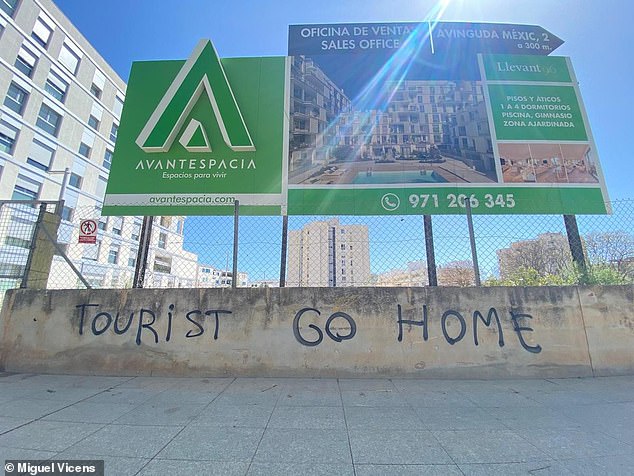
“Tourist Go Home” appears scrawled in English on a wall beneath a property development sign in Nou Levante, Mallorca, a neighborhood that has seen a massive influx of foreign buyers in recent years. It is one of the many cases of anti-tourism graffiti.
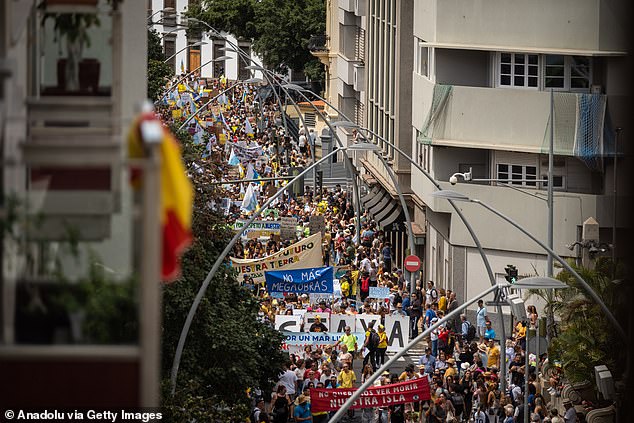
Protesters flooded the streets of Tenerife last month (pictured), calling on local authorities to temporarily limit the number of visitors to ease pressure on the islands’ environment, infrastructure and housing stock, and put brake on property purchases by foreigners.
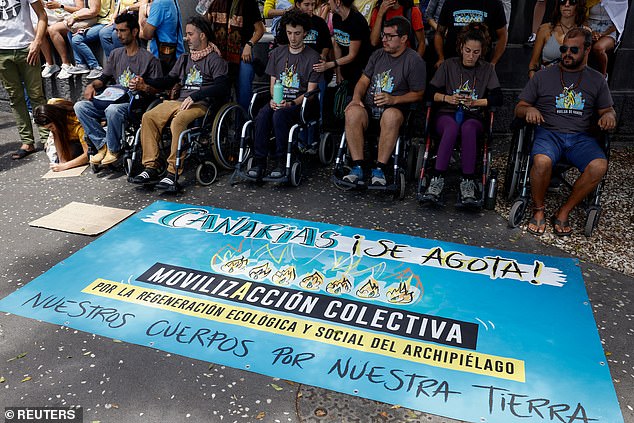
Hunger strikers sit in wheelchairs during a protest for a change in the tourism model in the Canary Islands, in Santa Cruz de Tenerife, Spain, last month.
He said that the Balearic economy has so far developed with a growth pattern based mainly on “volume and quantity” and that it has been “incapable” of growing in “value or quality.”
But he warned that the model change will not be active for one or two years.
‘Today we begin to work for a great social and political pact for the social, economic and environmental sustainability of the Balearic Islands,’ he stated.
‘The path to reaching agreements will not be easy but we owe it to the entire society in the face of the current situation of overcrowding of the archipelago and mobility problems.
The Balearic Islands received almost 18 million tourists last year and this year reservations for the summer have increased by 15%, confirmed the president.
The Government will launch a macro survey among the residents of the Balearic Islands to find out their opinion, quantify this summer’s traffic on the main roads and monitor the influx of visitors to tourist areas and certain natural enclaves.
The protests in Mallorca come after more than 50,000 people took to the streets of Tenerife in April to protest against tourism on the Canary Island.
Protesters were seen brandishing banners reading “you enjoy, we suffer”, stating that the huge influx of tourists to the island is causing significant environmental damage, driving down wages and squeezing locals out of cheap and affordable housing, forcing dozens to live in tents and cars. .

